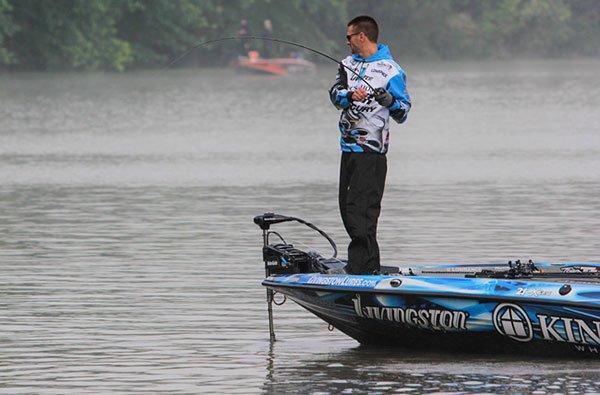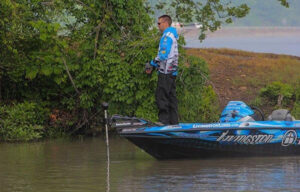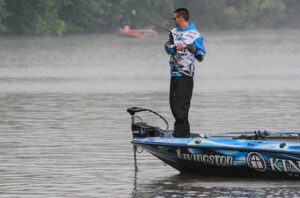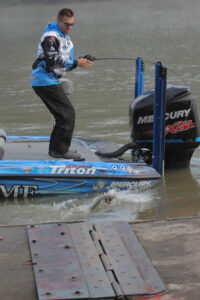Finding and patterning fish is perhaps the most difficult aspect of this sport. While some fishing techniques require hours, or even days, of constant experimentation and fine tuning, fishing boat ramps offers anglers a great opportunity to catch a quick limit of bass throughout most of the year.
2014 Bassmaster Classic champion Randy Howell has benefitted greatly from fishing boat ramps in his career. When the bite gets tough and he needs to fill his limit, he never hesitates to locate and dissect these overlooked bass fishing hotspots.
Why boat ramps?
Many anglers use boat ramps when loading and unloading their boats, but rarely will you see someone casting lures towards them. According to Howell, there are several reasons why these manmade structures are actually magnets for hot bass fishing action.
“Boat ramps are some of the most overlooked bass fishing targets. They’re easy to find, simple to fish and the possibilities are endless. They’ve saved me from some really tough fishing days throughout my career.”
- Holes—”Most boat ramps actually have washed-out areas in front of them that are created by people loading and unloading their boats,” Howell said. “When folks use their big motors to power-load their boats onto their trailers, small holes and mounds are created right in front of the ramp. When the ramps aren’t in use, big bass will relate to these depressions and humps throughout the day.”
- Hard bottom composition—”It’s no secret that bass love areas with a hard bottom composition,” Howell said. “In order to make it easier to load and unload boats, the gravel and cement extends into the water several feet—much more than you’d think. In a fishery void of suitable hard bottom, even the smallest ramps can hold surprisingly large concentrations of bass.”
- Crawfish—”After a few years of use, ramps will start to get little cracks and holes in them,” Howell said. “This creates a perfect environment for substantial populations of crawfish, which are an excellent protein source for big bass.”
- Shad spawns—”Throughout the late spring and early summer, targeting active shad spawns is an outstanding way to catch both quantity and quality,” Howell said. “For the first few hours of daylight, they love to spawn on hard surfaces and boat ramps are ideal places to find a bunch of activity. It’s not uncommon to pull up to a shad spawn and catch over 20 pounds in just a few casts.”
- Catching retreads—”If you can find a boat ramp that hosts a lot of community bass tournaments, you have an excellent chance of catching ’em big,” Howell said. “After the bass are weighed in on tournament day, they’re often released right there at the boat ramp. Some of the bass will swim away, but a lot of them will stay nearby for a few days. There are a handful of professionals that do very well using this technique—if your main areas aren’t producing, it’s a great fallback plan.”
Cover water quickly
Learning how to quickly eliminate unproductive water is a large part of an angler’s bass fishing success. Instead of spending a lot of time on specific boat ramps, Howell covers water at a rapid pace while using fast-moving reaction lures to find the most active fish.
“Fishing boat ramps allows you to move around pretty quickly and cover huge stretches of a lake within a very short period of time,” Howell said. “Because a lot of these fish have been previously released from tournaments, they’re not always in the mood to feed aggressively, which is why I start with a crankbait almost every time. They may not be hungry, but they can’t help themselves when they see a crankbait knocking around in the area.”
Due to the rocks, concrete chunks and other obstructions often found near boat ramps, Howell urges the importance of a squarebill or coffin bill crankbait. It’s very important to beat the crankbait against any available cover and these bill styles aid in optimum deflection to reduce hang-ups.
Still not getting bites?
Howell suggests rigging a 4-inch Yamamoto Senko on your shaky head when the bite gets tough. This smaller presentation can do wonders in this situation!
“One of the quickest ways to spook fish on boat ramps is by getting your lure snagged,” Howell said. “I use a Team Livingston Series Howeller Squarebill or Coffin Bill Crankbait and I simply reel at a moderate speed. Nine times out of ten, my bites come after the crankbait deflects off a piece of cover. Just keep a close eye on your line condition throughout the day because all of the rock and concrete will fray it from time to time. I use 12 to 14-pound Gamma Edge Fluorocarbon and check it frequently for any rough spots. “
If he fails to get a crankbait bite within roughly a dozen casts, Howell isn’t too quick to give up and move on. He’ll spend a few more minutes utilizing his “cleanup” baits—a 1/4-ounce Lunker Lure Shaky Head and a 3/8-ounce Lunker Lure Triple Rattleback Flipping Jig.
“When they won’t eat a crankbait, I’ll definitely pitch a shaky head or jig around before leaving,” Howell said. “I’m still fishing quickly, but that doesn’t mean I need to ignore what the fish are telling me. In high, bright skies they may not always want a crankbait, but that’s when the more deliberate approaches shine.”
Pay attention to casting angles
You can definitely catch bass casting perpendicular to the bank, but paying close attention to your casting angles can make a huge impact on your success. After a few bites, you’ll get a much better feel for the most productive depth zones.
“Most of the time I’m going to throw at a 45-degree angle to the boat ramp,” Howell said. “I’ll look at the SideScan on my Lowrance and make sure I stay as far away from the end of the ramp as possible. These quartering casts allow me to more thoroughly dissect each depth zone and put my bait in front of more fish.”
Additional cover is a major bonus
So you just whacked ’em on a certain boat ramp but now you can’t even buy a bite on an identical looking ramp. What’s the deal? Howell suggests surveying the surrounding area for clues.
Howell’s cranking arsenal:
- Rod: 7-foot, medium-light Daiwa Tatula Casting Rod
- Reel: 7.3 gear ratio Daiwa Tatula Type-R for added control while fighting fish
“If you’re having trouble duplicating a boat ramp pattern, pay close attention to nearby cover,” Howell said. “Bass are much more likely to hang out around boat ramps with plentiful cover. It could be floating docks, riprap walls or even a nearby laydown—the more options those fish have, the better chance they’ll stay in the area because they’ll have everything they need to thrive.”
Characteristics to look for
Large fisheries play host to a multitude of boat ramps and unfortunately, each ramp won’t have a bass on it. In order to concentrate your approach, Howell suggests looking for the following characteristics.
- Depth—”Whenever I find a boat ramp with about four to six feet of water on the end of it, I usually catch a few fish,” Howell said. “That’s not to say you can’t catch some in different depths, but this depth zone seems to be the most productive for me throughout most of the year.”
- On a point—”Ramps located near or on points are great places to catch bass,” Howell said. “Even if the point is fairly shallow, there’s probably some deep water in the vicinity and big bass love having that security. When they’re inactive, they can slide into deeper water and when they’re ready to feed, they can sit on the end of the ramp and gorge on shad and crawfish.”
- Wind—”Wind always seems to make bass bite a little better,” Howell said. “When you find a little breeze hitting a boat ramp, your chances of catching a fish skyrocket. This will position the baitfish tighter to the bank, effectively creating a buffet for bass. Not to mention, the surface disturbance will break up the outline of your crankbait and make it difficult for the bass to distinguish any unnatural characteristics such as hooks and split rings.”
The next time you find yourself struggling to catch bass, don’t overlook the effectiveness of boat ramps—these structures have all the makings for phenomenal bass habitat. If you can utilize the proper casting angles, understand what to look for and cover water efficiently, you have a great chance of turning a tough day into an unforgettable one.















